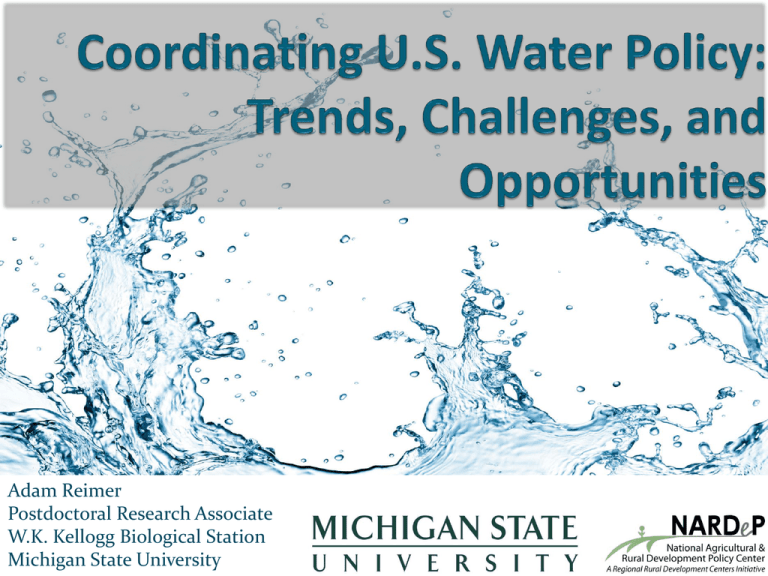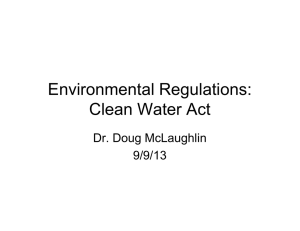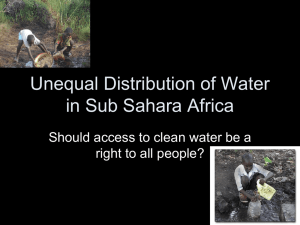Coordinating US Water Policy: Trends, Challenges, and Opportunities
advertisement

Adam Reimer Postdoctoral Research Associate W.K. Kellogg Biological Station Michigan State University 1 Webinar Outline Brief history of U.S. water policy Major federal water laws and agencies Ongoing and emerging challenges Recent policy trends and innovations 2 Overview of Water Policy Two traditional threads Water use/ consumption Water quality Policy fragmentation State vs. federal Increasing: coordination landscape-scale management public involvement ecosystem restoration adaptive management 3 4 History Colonial-1850: local control and abundance 1850-1900: expansion, transport 1900-1950: water supply infrastructure 1950-1980: Environmental era 1980-2000: Devolution, experimentation, and collaboration 5 6 Clean Water Act (CWA) Passed in 1972 Two major mechanisms: Designate uses and WQ standards for waterways Regulate point sources of pollution National Pollution Discharge Elimination System (NPDES)—national permitting system 7 Other Federal Laws Safe Drinking Water Act (SDWA) Public drinking water standards Drinking Water State Revolving Fund Water Resources Development Act (WRDA) New bill in conference now 8 Water Agencies U.S. Army Corps of Engineers (USACE) Traditionally focused on navigation, flood control Manages 25% of U.S. hydroelectric power Bureau of Reclamation Provides water storage for irrigation, drinking water, recreation 9 Water Agencies Environmental Protection Agency (EPA) Primary federal agency in charge of water quality Administers CWA provisions, including: NPDES List of impaired waters Technical, financial resources for pollution reduction CWSRF & DWSRF 10 11 Water Supply 12 Water Usage by Sector Municipal supply: residential & commercial uses 4% 3% 1% 1% Power Generation Agriculture 11% 49% Non-domestic Public Supply Industrial 31% Livestock and Aquaculture Mining 2005 USGS data, last year federal estimates are available 13 Water Supply: Surface Water Rights Three traditional state doctrines Riparian rights (eastern states) Water rights part of property Prior appropriation (western states) “First in time, first in right” Hybrid systems (Great Plains & Pacific coast) 14 Water Supply: Groundwater Groundwater policies disconnected from surface water Some states combining ground- and surface water policies Typically first come, first served policies Mostly privately developed Groundwater depletion serious concern 15 Groundwater depletion between 1900 and 2008 (source: USGS) 16 Water Supply: Emerging Issues Prior appropriation: no efficiency incentive Use it or lose it States adjusting policies Increased pressure on existing water supplies Population growth Increased per capita use Aging infrastructure State, local (and private) systems, with federal support Clean Water Action (cleanwater.org) 17 Water Supply: Efficiency and Conservation Mostly state/local effort thus far (EPA technical support) Water loss management Water reuse and recycling programs Market mechanisms Cooperative water management Conjunctive land use and water planning 18 Water Supply: Climate Change Girvetz, Roy, and Maurer (Tetra Tech Consulting). 2010. Water sustainability in the contiguous United States. Evaluating Sustainability of Projected Water Demands Under Future Climate Change Conditions, Natural Resources Defense Council. 19 Water Quality 20 Water Quality Environmental movement of 1960s changed perception of water Initial concern with point source pollution Heavy metals, sewage, petrochemicals, PCBs CWA, NPDES 40 years after CWA, still significant impairment Impaired Waters of the US: 100,000 miles of rivers and streams 2.5 million acres or lakes 800 mi2 of bays and estuaries 55% of streams in poor condition for aquatic life (source: EPA) 21 Water Quality Nonpoint source (NPS) pollution Variety of sources, difficult to identify Nutrients (N&P), sediment, road chemicals Now major source of water impairment Source: NOAA 25% of streams with too much N 40% of streams with too much P 22 http://serc.carleton.edu/microbelife/topics/dead zone/general.html 23 Emerging Pollutants of Concern Household chemicals with uncertain impacts Pharmaceuticals Household cleaners Personal care products Widespread 24 Emerging Pollutants of Concern Kolpin et al. 2002. Pharmaceuticals, hormones, and other organic wastewater contaminants in U.S. streams, 19909-2000: a national reconnaissance. Environ. Sci. Tech. 25 Water Quality 1990s transition to holistic WQ management 1992 CWA amendments: Total Maximum Daily Load (TMDL) Whole water body management Determines uses, calculates acceptable pollutant levels Apportions levels to various actors 26 Water Quality TMDL process addresses PS and NPS Mandatory limits for PS, only voluntary for NPS Watershed-based, cut across political boundaries Public involvement Courtesy NRCS 27 28 Coordination and Collaboration Agencies increasingly working together Federal-state-localprivate collaboration Integrate water supply mgmt, WQ mgmt California Federal-BayDelta Program (CALFED) 29 Watershed Management •Management by basin, rather than jurisdiction •Goes hand-in-hand with coordination and collaboration •Targets NPS •TMDL process •Citizen involvement key •Civic watershed groups related to implementation of TMDL plans1 1Hoornbeek, J., Hansen, E., Ringquist, E., and Carlson, R. 2013. Implementing water pollution policy in the United States: Total Maximum Daily Loads and collaborative watershed management. Society and Natural Resources 26: 420-436. 30 Public Involvement Public awareness of water issues Multiple use management EPA 319 Program 31 Ecosystem Restoration Hundreds of years of water system modification and degradation Loss of ecosystem services: Flood control & storage Water filtering Wildlife & fisheries habitat Storm protection Example: Comprehensive Everglades Restoration Plan 32 Adaptive Management Experimentation in policy design Importance of monitoring, flexible administration Response to climate change Courtesy: Government of British Columbia 33 Questions 34











